“Mother of the Abyss” by Forest-Walker, Creative Commons Attribution-Noncommercial-No Derivative Works 3.0 License.
This article contains affiliate links that add gold to our coffers.
With a thirst for knowledge and power, a Warlock submits themselves to a supernatural being with greater capabilities than their own, unlocking life-altering magic and arcane secrets. Though typically played as devious and creepy, a Warlock could have a myriad of motivations toward and responsibilities to their patron that are less-than-spooky.
The purpose of this article is to help players find a Warlock patron with the lore, goals, and abilities that fit into their character build and background, as well as to help players flesh out roleplaying and world-building aspects of their adventurer to share with their Dungeon Master.
To read more about Warlock spellcasting, check out our Warlock Invocation and Spell Guide here.
Warlocks by the Book
From the class description, we know that Warlocks often make pacts with fiends, hags, and high-power monsters, but “more often[…], the arrangement is similar to that between a master and an apprentice. The warlock learns and grows in power, at the cost of occasional services performed on the patron’s behalf.”
A player and their Dungeon Master should decide together how much of an impact the Warlock’s patron will have on the character’s motivations and goals as well as the campaign as a whole. A patron could interrupt an adventure with their own instructions; a patron might have an overarching goal for the Warlock for the entire campaign; a patron could be a complete mystery to the character and may be slowly revealed throughout the story. All of these scenarios require careful planning with a Dungeon Master and a basic understanding of their patron.
When developing a Warlock, a player should consider what specifically drove them to making a pact with a patron. A Dungeon Master may decide why a patron accepted the pact, but together, player and Dungeon Master should develop a backstory that lays out goals, motivations, events that led to the pact, and what plans a patron may have for a Warlock.
Patron Relationships
Your story as a Warlock began with a pact between yourself and your patron. The basis for the pact will vastly differ between Warlocks and can lie somewhere between noble and malicious. Below, we will list basic lore about each of the patrons to help a player gain a better understanding of the nature of their pact. We will also list possible pact motivations and how a patron might hold a player to their pact.
When reading through these patrons, recall this information from the Warlock class description: “No one makes a pact with such a mighty patron if he or she doesn’t intend to use the power thus gained.” Both parties, the patron and the Warlock, seem to benefit from the contractual relationship.
Archfey
Celestial
Fiend
Noble Genie
Great Old One
Hex Blade
Lurker in the Deep
Raven Queen
Seeker
Undead
Undying
Archfey
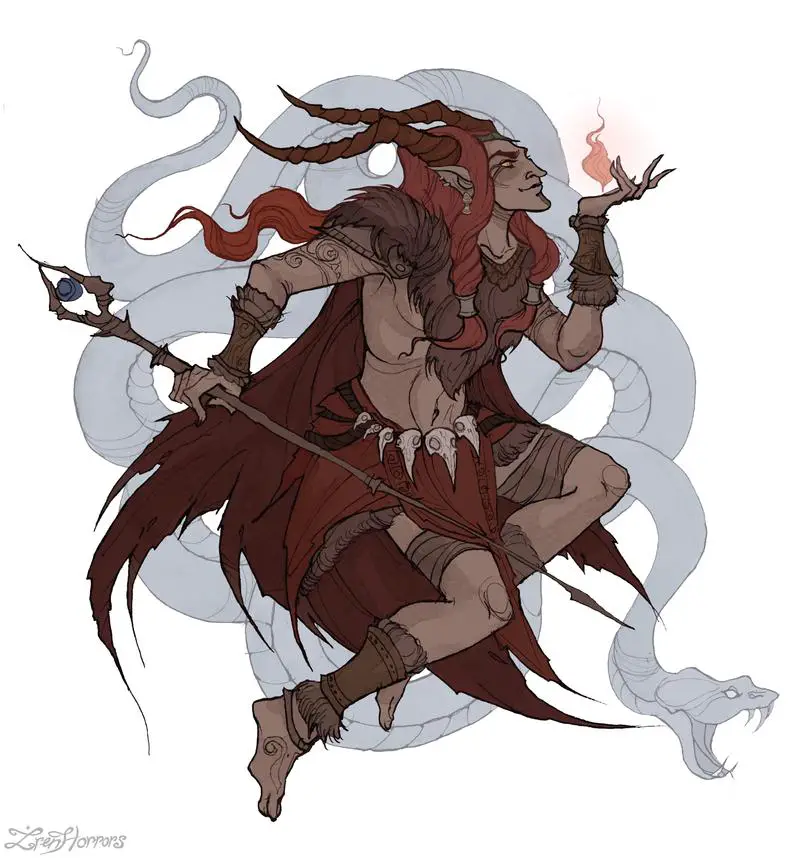
An Archfey patron is characterized as a legendary fey creature who holds secrets unknown to mortals. Typical to fey creatures, Archfey patrons may be eccentric in their motivations and may utilize Warlocks to fulfill deeds of their ancient resentments. The following are part of the Archfey patronage.
Art by IrenHorrors, CC License.
Prince of Frost: In Dragon Magazine Issue #374, we learn that the Prince of Frost is an icy-blue eladrin with a cruel nature. Once known as the Sun Prince, lord of the realm of summer and warmth, he tragically lost the love of his life who grew bored of the revelry of the fey and gave her heart to a mortal folk hero. Making a pact with the Raven Queen, she pleaded with the deity to cast her and her mortal lover’s souls far into the future to avoid the Sun Prince, who grew embittered and literally frosty. Now ruler over the Vale of Long Night within the Feywild, a moon-enshrouded and ice-covered winter citadel, the Prince of Frost built his fortress out of arctic tears of sorrow, adorning the palace with ice statues of frozen mortals. The Prince is known for his control over winter elements.
From this source, it can be assumed that the Frost Prince hates mortals. Why would he make a pact with one? Perhaps to use them as pawns, easy fodder, in his obsession with finding his lost lover. Perhaps to punish the warm fey he shunned or other mortal beings, symbols of the one who stole his companion. A player might expect this patron to be petulant and expectant. Disappointment would risk an instant severance of power. A player might be interested in tailoring their powers to the theme of a cold and dark winter, such as Armor of Agathys, Darkness, Banishment, Elemental Weapon with cold damage type; or means to control other mortal creatures, who are also pawns to the Frost Prince.
Queen of Air and Darkness: An intangible looming presence who rules over an institution of evil fey, the Queen of Air and Darkness lacks physical form but appears as a formidable and handsome female faerie avatar. The Queen of Air and Darkness rules over the Unseelie Fey, or the Gloaming Court, antagonists to the Summer Court and Queen Titania, the sister of the Queen of Air and Darkness. This macabre patron who revels in hatred, enslavement, and death is opposed by seven deities for her corruption of the fey lineage, a result of the influence of a great black diamond offered to her by dwarven miners. The Queen of Air and Darkness is fond of yeth and hell hounds and is served by brambles, quicklings, and spriggans.
Servitude to the Queen might be a form of enslavement to her. A creature under her tutelage might experience corruption and greed. It is unclear what the goal of the Queen might have as a patron.
Titania of the Summer Court: Queen of the Summer Feywild and the fey patron deity, mightiest of all archey, the Faerie Queen Titania is an accomplished strategist with a dry sense of humor and practical level head. Peculiarly, Titania is affectionate to and amused by mortal beings. Like other sylvans, Titania is immune to paralysis, illusions, power words, and physical damage. Adept at charming and woodland magics, Titania fondly stewards all fey beings: brownies, dryads, pixies, satyrs, sprites, treants, unicorns, and so forth. Historically, Titania has been patron to many Warlocks throughout the Realms.
Titania’s goals include preserving the faerie lands and ushering peace between the courts in the Fey. This patron may truly have an apprentice-master relationship with a Warlock.
Oberon, the Green Lord: From Monster Mythology (1992), we discover that the King of the Seelie Court and fey deity, the Green Lord, is a mighty tracker and skilled warrior, finding strength in his attunement to nature. Like a river, Oberon is volatile in his emotions; like a great oak, the Green Lord is strong and stern. To avoid the political machinations of the court, and instead of employing wily illusions and magic, Oberon protects the fey with physical combat and brute strength. The god himself enjoys roaming in the Beastlands.
This patron would take well to a Warlock who uses weaponry to fight while retaining a somewhat good alignment—one who is friend to nature and hopes to protect creatures of the fey. This deity would also work well in an apprentice-master relationship. Find invocations and spells that are communal with nature and its strength.
Hyrsam, the Prince of Fools: A savage trickster with mischievous tactics and a cunning will, this satyr archfey is titled the Prince of Fools, though not because he lacks intelligence. In his guile, Hyrsam plays the fool to have covert advantage over dismissive political players, finding ways to manipulate his foes. Rumored to be the incarnation of music, and skilled in charming music, this immortal being attracts many races from the fey and other realms, like githyanki and genies.
Hyrsam may use a Warlock in his web of plots and political games. A task from Hyrsam may seem inane but reveal extreme outcomes in due time, all according to the plan of the Prince of Fools.
Ancient hags: Sustained by maleficence, hags are the embodiment of ugliness, the repugnant counter to the Fey. Evil sustains the hag, and manipulated souls do their bidding, finding joy in the misfortune they sow. Often unfathomable in their motivations, a hag is selfish, savage, unpredictable, and volatile. However, hags are unequalable as keepers of forbidden knowledge discovered through dark divinations and arcane pacts.
A Warlock may find himself bound to a hag patron through a bargain that results in a compromise of a Warlock’s morals and complicitness in their own corruption. Hags rarely hope to get anything out of the bargain except sheer elation at watching a mortal fall, though they sometimes have pragmatic intentions. A bold player may use this patronage to seed her own demise without the promise of redemption. To quote Elminster from Volo’s Guide to Monsters, “The hags put a spell on me, three times three, and made me their slave for a thousand days. I was a young fool, ‘tis true, but those were dark days.”
Celestial
Xanathar’s Guide to Everything
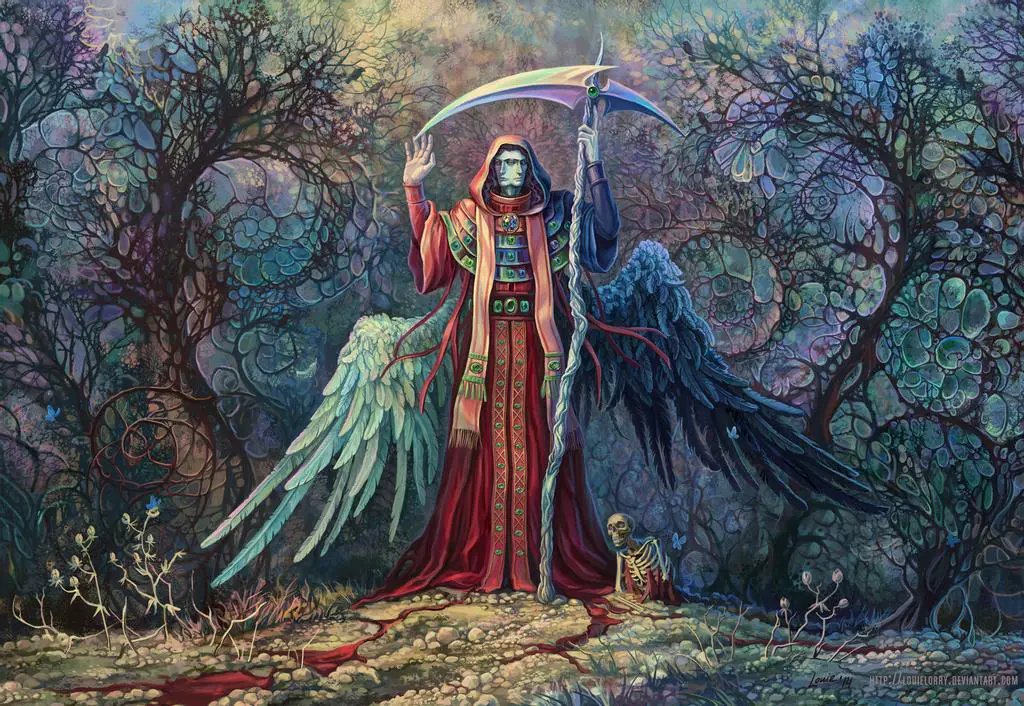
Residing in the Upper Planes, the planes of everlasting bliss, a Celestial patron is filled with radiant light with the power to change the world of mortals for the better. A Celestial patron incites a Warlock to “bring light to the dark places of the world.” The following are a few examples of Celestial patrons.
Art by LouieLorry, CC License
Ancient Empyrean: Descendants of the deities of the Upper Planes, Empyreans are unaging majestic manifestations of beauty and strength whose intense emotional influence could alter their surroundings: radiant sunshine, sprightly creatures, a world of song and joy when happy; or withering flora, caustic rains, and ailing animals when moody. An Upper Plane Empyrean is typically altruistic, but corruption from the Lower Planes could curse and banish the deity. Innate spellcasting to an Empyrean includes nature-based spells like Earthquake, Fire Storm, Water Breathing, and Water Walk, or benevolent spells like Comune, Dispel Evil and Good, and Greater Restoration.
A Warlock who enters a pact with an Ancient Empyrean might find themselves a steward of light, compelled to fight evil wherever found. An Empyrean might share its power with a Warlock so long as they fulfill this purpose.
Solar: Holy celestial angels who loyally serve the divine being they wear allegiance to, Solars sow fear into even the most powerful fiends. Though they never took on their own worshippers, Solars sometimes summoned the aid of other celestial beings. Solars have access to immensely powerful magic, like searing bursts of energy, true sight, psionic abilities, flight, and regeneration. The greatest divide in Solar personality is favoring law or freedom over the other. Embodying virtues like devotion, honor, and purity, Solars were created as rewards for their gods, and failing to serve could result in a loss of power and demotion.
A Warlock who took a Solar as a patron would need to be devout to the god the Solar served. This Warlock should act more like a Paladin or Cleric and not deviate in the slightest from their morality.
Ki-rin: Celestial golden hooved equine creatures, Ki-rin serve good deities and oppose evil. Though extremely resistant to magic, Ki-rin avoid violence and would rather render their foes unconscious than fight. From the 2nd Edition Monster Manual, we learn that, though seldom found, a Ki-rin may be discovered gracefully searching the sky above the material plane for too-powerful evil-doers to punish.
Those who help the Ki-rin may share their goals in stopping evil and destructive creatures. A Ki-rin may inform their Warlock of the location of these beings, though they may require non-violent methods.
Fiend
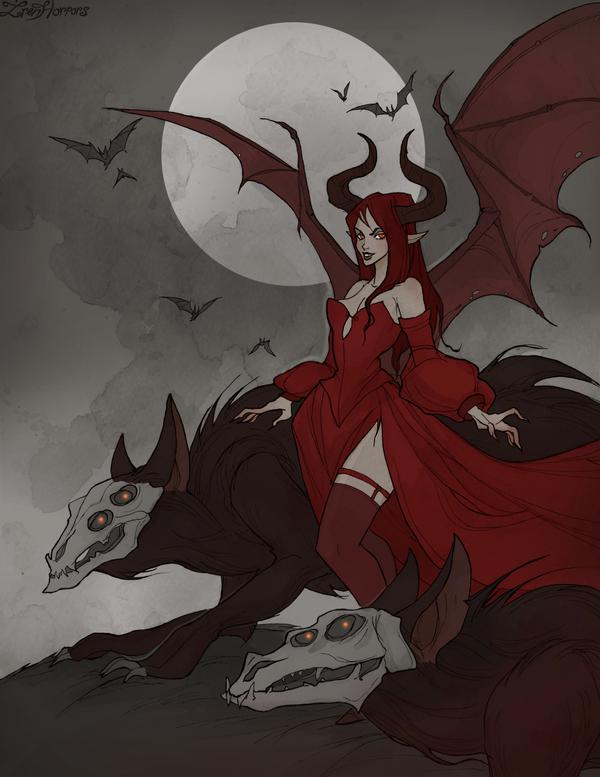
Evil beings from the lower planes of existence, a Fiend patron desires “the corruption or destruction of all things, ultimately including you.” A pact with this patron may be the only option for a desperate Warlock, or maybe the power of a fiend tempts a Warlock who thinks they are cleverer than their patron, though only an extremely powerful fiend could forge a pact.
Art by IrenHorrors, CC License
Demogorgon: Considered a demon lord and lesser Abyss deity, Demogorgon, the Prince of Demons, has earned his title by defeating all who challenge him for his honorific. Crowned with two baboon heads atop his shoulders, Demogorgon is a dual creature who endures his own internal dissonance. The left head, named Aameul, is charismatic, cunning, and deceptive. Hethradiah, the right head, is impulsive, feral, and destructive. With magical abilities and servants that allow him to avoid direct conflict, Demogorgon relishes in control of other beings, disease, and fear. Demogorgon is also a creator and experimenter, having constructed retrievers, ettins, and the first death knight. Demorogon has a small but strong cult of worshippers from several races.
According to Volo’s Guide to Monsters and the Player’s Handbook, Warlocks who make a pact with Demogorgon typically keep quasit familiars and are rewarded boons for their devotion. In their adoration, these Warlocks mimic the fiend in his spellcasting, using spells like Charm Person, Enlarge/Reduce, and Vampiric Touch.
Orcus: Master of the undead, Orcus is a large demon lord who loathes all other living things, including his own worshippers and the undead. Orcus’ story began as a wicked mortal spellcaster on the Prime Plane, whose chaotic evil soul found its way to the Abyss. Rising from a larva through the demon ranks, Orcus eventually ascended to his position as demon lord and hungers for Demogorgon’s title of Prince of Demons. Orcus has been defeated many times and resurrected to rise in the ranks again.
A former Warlock of Orcus strived to become a lich, though lost his power when Orcus lost his power-delivering skull-topped wand. A Warlock now might be an Orcus fanatic who has a fascination with the undead, such as a Warlock necromancer. A player might try to trade off power with this patron who has been defeated many times before despite his intended fate by Orcus.
Fraz’Urb-luu: Known as the Prince of Deception, Fraz’Urb-luu was one of the first demons to gain great power and possesses many magical abilities like darkvision, true seeing, telepathy, and speaking all languages, but his crowning talent lies in his mastery of deception and summoning. After major terraforming and erecting beautiful structures upon the layer of Abyss he ruled, his power grew too strong to challenge. The Prince, who ruled several demon hordes, would deceptively summon demons to his courts and take their possessions that were desirable to him, until his true name was discovered by a pair of mortals who eventually trapped him in a black jewel that corrupted many beings until its destruction, placing the Prince of Deception back into the Abyss. Now, his cultist priests trick beings into serving the demon until they eventually sacrifice themselves to him. Fraz’Urb-luu desires revenge against mortals for his imprisonment and degradation.
Serving Fraz’Urb-luu, a Warlock might be tasked with finding valuable treasure for the Prince that would increase his power. The Warlock may also be unaware of the malevolent deeds they are accomplishing and the corruption they are internalizing.
Baphomet: Ruler of the infinite Endless Maze in the Abyss, the Prince of Beasts and Demon Lord of Minotaurs, Baphomet, breeds new types of demons in his Tower of Science and hunts lost humans and gnolls in his labyrinth. With the acute intellect of a scientist but erratic temper of a bull, Baphomet is primed for brutality, believing that all creatures are soulless beasts, and that those who embrace the beast within are truly free. Most who serve Baphomet are unaware of his identity or too impatient for religion.
A Warlock who pacts with Baphomet may have embraced their brutal, savage, cruel, and barbaric ways. A Minotaur Warlock would especially fit this build, particularly Cabalists who wish to enslave all other mortal beings.
Asmodeus: As the leader of the devil race, this lawful evil Duke of Hell seeks power over others. Divisively altering the form of lesser devils as curses or blessings, Asmodeus is the apex of devils: cunning and strong. Quick to instigate discord among the evil gods, he’s ready to form alliances that eventually lead bickering gods’ followers to him. Asmodeus employs many mortal beings in his goals of oppression, exploitation, and domination.
Warlocks who pact with Asmodeus seek power for themselves. Seen as reasonable and eloquent, Asmodeus may trick humans into serving him in trade for power and rewards so long as they signed their eternal soul to him, the result of which is eternal servitude after life.
Dispater: Lord of the second layer of Hell, this archdevil has a human look except for his horns, tails, and left hoof, and is known for always having an extreme number of backup plans as a result of his excessive caution. This calculating devil, who avoids big risks, spreads the dogma of conservative evil in terms of contingencies and options for those who value malice but also safety. Worshippers focus on impregnable fortress-building, defensive strategies, and escape plans. Goblins are typically fond of this archdevil. Always interested in learning a new secret, the Dispater calculates the value of all things by how they reveal the true nature and mysteries of the universe.
This fiend would likely accept an apprentice Warlock who was similarly cautious and conservative in their actions, though having a pawn to learn the secrets of the universe in his place would ensure his safety while accomplishing his goals.
Mephistopheles: A capricious megalomaniac with a fiery temperament and appearance, Mephistopheles is a cool and calculating fiend on the surface with infernal flames hidden within. While he might appear gentlemanly and pleasant when speaking candidly, he hides a prideful, reckless, and explosive disposition that drives him to disintegrating distracting underlings and executing annoying minions. Brazen ambition in dramatic fulfillment of vile plots and deeds reveals his entitlement and jealousy at being the second best fiend. Mephistopheles is a master of fire and an expert at evocation magic that often results in complete obliteration. He is also quite disinterested in enchantments and illusions.
This fiend takes much pride in the appearance of dread. An ambitious Warlock with the potential of power might interest Mephistopheles, as adding such a magnificent destroyer to his retinue would make him look even more powerful. His unstable personality might either be rewarding or dangerous to a Warlock, but one could manage well under his tutelage as a fond, self-sustaining, adoring worshipper who strokes Mephistopheles’ ego strategically.
Belial: Conspiracies and lust are the crowning jewels of this lord of Phlegethos. His confidence and vanity as well as astute judgement and ambition sculpt his smoldering physique, complimented by his love of manipulation and domination. It’s said in Fiendish Codex II that Belial finds pleasure in feeling the hot blood of his kills against his skin. Due to the complex and manipulative machinations of hell’s politics, Belial focuses his time on the administrative aspects of ruling Phlegethos, including overseeing the judicial system of the Diabolical Court, while his daughter handles the rest under his supervision.
Worshippers of Belial see Belial as a powerful fiend with great secret knowledge of dark power and seduction who may help on their journey to personal corruption, finding pleasure in their fleshly pains and earthly gains. A Warlock of Belial may be sadistic and searching for power for themselves.
Noble Genie
Unearthed Arcana/Tasha’s Cauldron of Everything
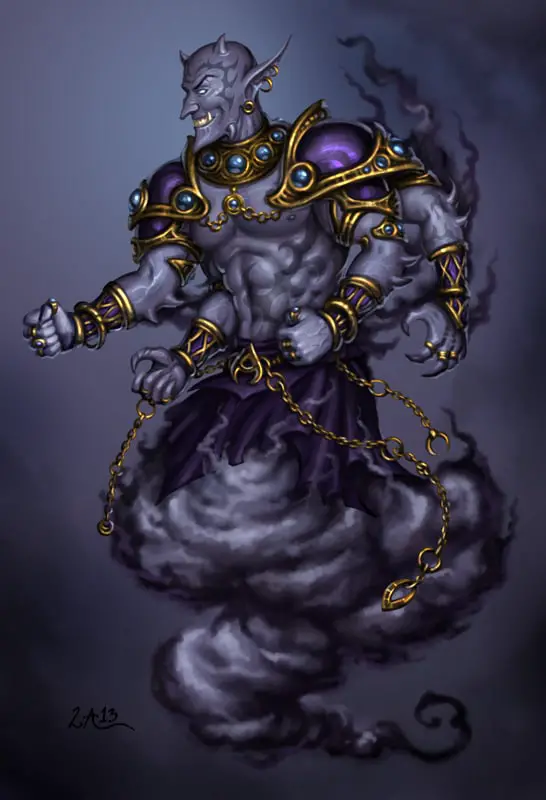
Rulers of elemental beings and genies, a Noble Genie is arrogant and powerful. Because genies are often bound in servitude by mortal creatures, a Noble Genie revels in returning the favor by enslaving Warlocks in strict pacts. There are four elements to choose from when deciding on a Noble Genie to serve.
Art by Candra, CC License.
Noble Dao (Earth): Noble Dao rule genies on the Elemental Plane of Earth and have an extreme obsession with precious gems, often enslaving elementals and other beings of the plane to mine them. Cunning and wary, Dao rarely enter battle carelessly without the promise of victory. These genies enjoy stealing and buying property from others, though some find pleasure in destroying what others own for its own sake.
A Warlock may promise the return of wealth to a Noble Dao for access to their powers. Slacking off on that promise may result in tight proverbial chains and stringent enslavement.
Noble Djinni (Air): Noble Djinni rule genies on the Elemental Plane of Air. Notably capable in magic, djinn are expert conjurers and illusionists as well as wish-granters. Low-maintenance in their rulership of other creatures, Noble Djinn are cooperative and tolerant.
There is not much information on Air Djinn that would indicate why they might accept a Warlock pact, but compatible circumstances like being an air genasi or enemy of the efreet may entice a Noble Djinn to accept an apprentice and powers.
Noble Efreeti (Fire): Evil warlord rulers of the efreet, Efreeti employ both physical and magical attacks and are known to corrupt those who summon them. Considering all creatures as subservient or adversaries, the Noble Efreeti wreak terror upon all inhabitants of the Elemental Plane of Fire.
A Noble Efreeti might accept a pact with a Warlock under the circumstances that the Warlock is a servant to the Efreeti. Lawful Evil by nature, a Noble Efreeti would likely honor the pact so long as the other side acquiesced.
Noble Marid (Water): Hulking masters of the ocean, the Marid genies fluidly transformed from raging rivers to foggy clouds to giant humanoids. Mighty archmages, Marid often controlled the elements and weather and used detection and self-transmutation spells. Noble Marid considered other creatures and races insignificant and not worthy of their time unless it influenced their political position in their higher courts.
Noble Marids may accept a Warlock pact for this very purpose—political machinations that increase their standing, though their call would be infrequent and strategic.
Great Old One
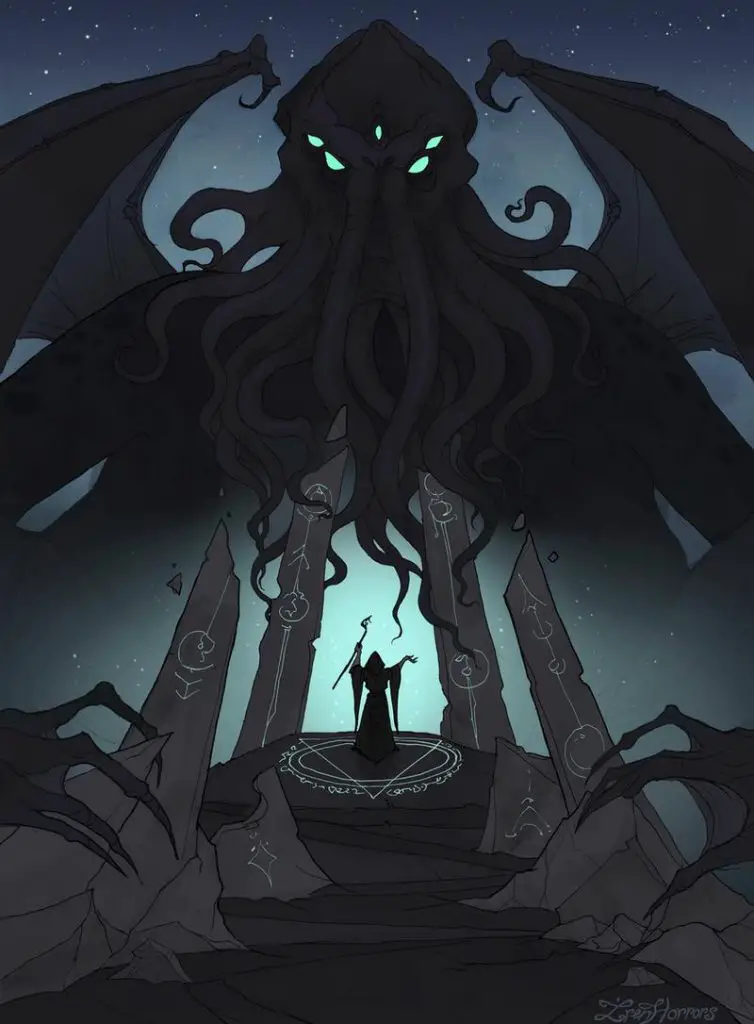
Mysterious and otherworldly, the Great Old One patron is foreign and incomprehensible to mortals, but their knowledge of ancient mysteries of the universe is practically infinite and definitely desirable. A Warlock may make a pact with a Great Old One without really understanding what’s at stake. Here are a few Great Old One patrons.
Art by IrenHorrors, CC License.
Ghaunadar: God of Abominations and a greater deity originally in the drow pantheon, Ghaunadaur is deity to the castaway and rebellious underdark races. Erratic by nature and the epitome of chaotic evil, this patron often extended permanent magical gifts and boons to followers without reason, though he may also destroy them on a whim. This god enjoys suffering and communicates via telepathy. Those who serve this deity were required to do what would please it most, regardless of how abnormal or ambiguous. Clerics of Ghaunadar also found and killed each other to increase their status in the deity’s eyes.
Ghaunadar would be a particularly good patron for an ugly or outcast Warlock, especially if their race is from the Underdark. Acid, poison, and alchemist’s fire mark a Ghaunadar cleric, adorned with purple, green, black, and metallic colors.
Tharizdun: This forgotten god has one goal: total annihilation of all that exists. Creator of the Abyss and driven by the desire for power, Tharizdun was imprisoned by other gods and released in a controlled mirror realm of his own. Since Tharizdun has been long repressed, it is unknown what he teaches his followers, as he is usually frantic and unstable, but from the 4th edition Dungeon Master’s Guide, we learn that existing cults often express: “Channel power to the Chained God, so he can break his chains. Retrieve lost relics and shrines to the Chained God. Pursue the obliteration of the world, in anticipation of the Chained God’s liberation.”
Tharizdun, in moments of lucidity, might accept a Warlock pact that would help with his escape plans. Mandates from this patron would be few and far between but would have dire punishment if left unfulfilled by the next time he is sensible.
Dendar: Known also as the Night Serpent, this evil primordial elder devours nightmares from mortal and immortal beings by injecting them with a sleeping poison in order to fulfill her goals of ending worlds. It is believed that if she did not satisfy her hunger of nightmares, all beings would remember their terrifying dreams in excruciating detail.
A Warlock with Dendar as a patron would have the goal of causing people to dream so that his patron could feed upon their nightmares.
Zargon: This Elder Evil-race tyrant, who desires to drench existence in his slime, is heartless and merciless. With an insatiable hunger to feed on mortals, Zargon has incredible regeneration powers that make him essentially immortal. With his acid-dripping mouth, Zargon spews slime and summons oozes.
Immune to all divination spells, Zargon often selects strong Warlocks to serve him. A Warlock should focus on telepathy powers and gifts of the tongue.
Hexblade
Xanathar’s Guide to Everything
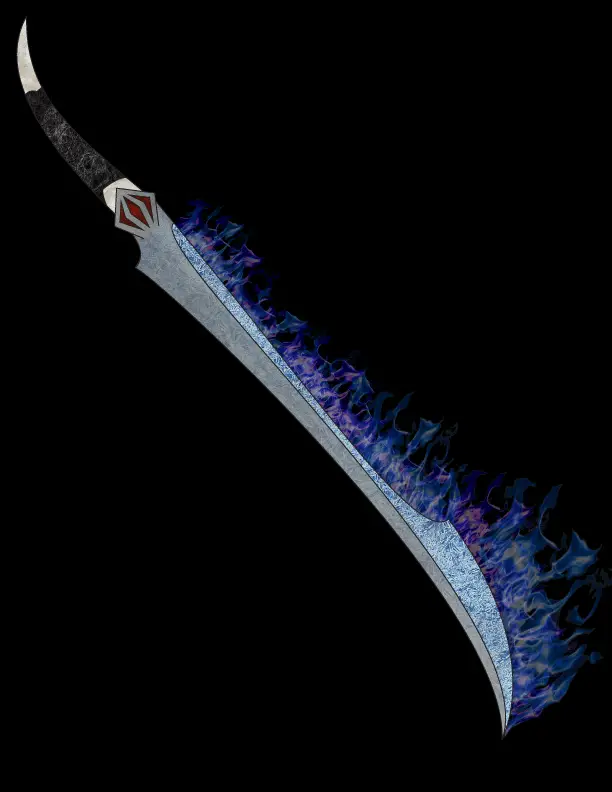
Entities of the Shadowfell, these patrons manifest as sentient magic weapons that present power to Warlocks in the form of a pact. Most Warlocks of this pact choose to wield weapons similar to their patron-avatar, but some will still default to using the magical powers bestowed upon them.
A Warlock may make a pact with any powerful creature of the Shadowfell, but Xanathar’s Guide to Everything implies that sentient magic weapons also accept Warlock vassals. Though any number of sentient weapons could be a patron for this pact, there is one that is most notable.
Art by Handofheaven, CC License.
Blackrazor: Possibly the most popular in this pantheon, this enchanted sword radiates evil and effuses the impression that it is controlling its wielder. This patron blesses with regenerative powers, immunity to charm and fear, and life force-draining abilities. Those who wield the sword are influenced to kill indiscriminately so that it could consume the souls of the victims.
Bonus Lore—The Living Axe: The Living Axe is a dwarven cult that worships sentient items, usually a weapon that serves as a prison for an evil spirit. Sects of this cult often followed a mysterious double-bladed bronzed adamantine battle axe. These members believed that dwarven-, halfing-, gnomish-, and human-smithed magic items were divinely constructed by the guidance of a noteworthy being that deserved worship. A Dwarven Warlock could easily come from this cult and make a pact with a Hexblade patron.
Lurker in the Deep/The Fathomless
Unearthed Arcana/Tasha’s Cauldron of Everything
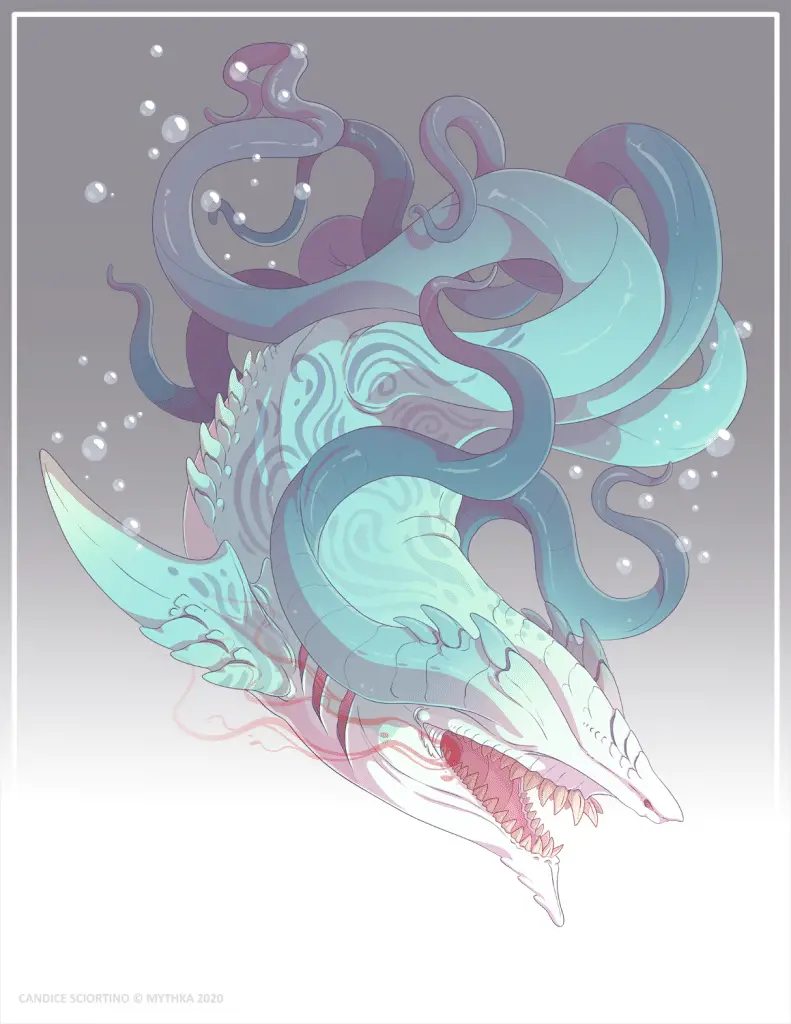
A creature who exists in the depths of the ocean or Elemental Plane of Water, a patron of this pact is typically a primordial monstrosity. A Warlock who receives this patron serves as an informant to the world beyond the patron’s observation. From the Unearthed Arcana version, we read that “You may have gained this pact as a member of a cult dedicated to the entity or after your patron saved your life when you nearly drowned at sea.”
Art by Mythka, CC License.
Kraken: Reputed as grim across all realms, krakens are highly-destructive deep-ocean dwellers who surface to terrorize sailors. Believed to have once been kings of the seas, krakens hope to one day again ascend to their dominant title. A Warlock of this pact may be bound to help Krakens regain their powerful position.
Raven Queen
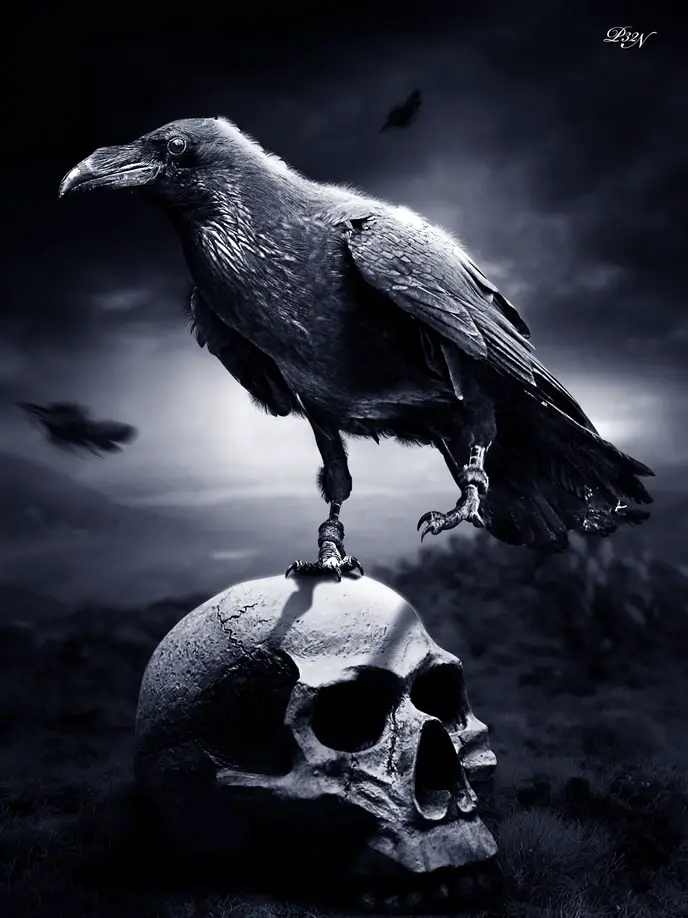
Ruler of the Shadowfell, the amorphous Raven Queen is the harbinger of death; the administrator of souls who pass from mortality to the afterlife. Because her icy palace is a derelict reflection of the mortal world, and her intangible existence a connection of sensory perceptions, she has limited influence over the mortal realm and relies on Warlocks to do her bidding of ensuring those primed for death meet their natural end.
Art by p32n, CC License.
Focused on collecting memories and emotions of loss and sorrow, the general motivations of the Raven Queen are unclear. Some speculate that the Raven Queen’s actions are unnecessary and an attempt to preserve her relevancy in the universe to keep herself from slipping into oblivion. Some believe her duties are cosmically necessary as a way to purify souls by realizing their fears and pains before passing to the other side.
Warlocks who accept the pact of the Raven Queen will focus on ending creatures’ lives when guided by their patron, then collecting trinkets and tokens of their strongest memories and offering them to her.
Seeker

Seeker patrons traverse the Astral Plane in search of lost secrets. A Warlock who accepts a Seeker patron will collect secrets and philosophies to offer to their Seeker patron in return for otherworldly powers. These patrons typically value learning and knowledge above all else. The following are example Seeker patrons.
Art by NathanPark, CC License.
Azuth: Interested in preserving the craft of magic as an art, this lawful-neutral white-bearded god is worshipped by arcane spellcasters and rules over the second layer of Arcadia. Clergy of Azuth preferred to associate themselves with powerful magic guilds and behave as a magical administration between spellcasters. By formulating arcane processes, these clergy further developed the channeling of the Weave.
Warlocks who accept Azuth as their patron will be interested in magic as a craft and a structured study, hopeful to expand the influence of the Weave.
Oghma: Known as the Lord of Knowledge, Oghma is a god of bards, inventors, scholars, artists, and sages, spreading inspiration and knowledge. Truly neutrally-aligned, Oghma rose to higher ranking among his pantheon by giving a tangible order and form to a chaotic landscape of shapeless concepts in the early days of existence, giving ideas and concepts physical form in the universe.
Warlocks of Oghma may express their worship in forms of poetry, song, or book. These Warlocks will be most interested in knowledge, which Oghma is known for.
Aureon: In a time long ago, Aureon, the Sovereign of Law and Lore, constrained and banished his inner evil, creating a monster called the Shadow who will destroy the world once rejoined with this patron. Represented as several avatars (gnome wizard, human wizard, or blue dragon), Aureon bestowed a clan of giants hidden knowledge and magic that ultimately brought about their destruction.
Warlocks of this patron should be educated and rational, understanding the need for law over their own emotional and physical desires. Truth is a virtue of Aureon and should be held as precious to his Warlocks with whom Aureon may have a mentor-apprentice relationship.
Gilean: A godly force of knowledge, Gilean the Sage believes that the soul can grow through acquiring knowledge and experience. Patron to scholars, sages, and librarians, Gilean values agency and individual choice. An unbiased observer, Gilean is typically a mediator between good and evil.
A Warlock of Gilean will value books and learning over all else. They may desire to promote education among the world.
Undead
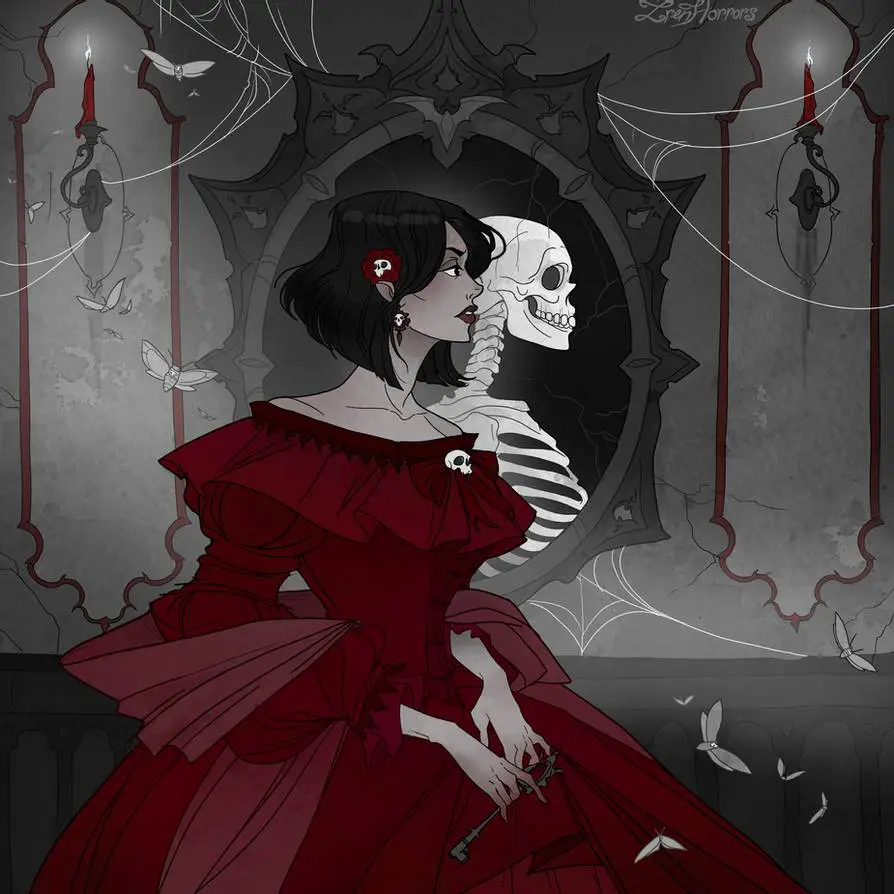
Experienced in knowledge from across their countless lifetimes, an Undead patron may be found in the darkest depths of the multiverse. Note that Strahd, Lord Soth, and Azalin are also listed in this patron list in the Ravenloft setting, but I am currently playing a Curse of Strahd campaign and would rather not come across any spoilers. Listed below is the other notable Undead patron.
Art by IrenHorrors, CC License.
Acererak: This fearful lich traversed the multiverse in search of powerful artifacts that he could insert into his trap-filled dungeons. Adventurers who died by such means would have their souls trapped in his repository. Rather than desiring to be worshipped, Acererak would rather enslave creatures into creating or discovering artifacts for his obsession.
Warlocks who serve Acererak may have unwillingly entered a pact with him. These Warlocks would utilize creepy spells like Magic Jar that would bind souls to their patron.
Undying
Sword Coast Adventurer’s Guide
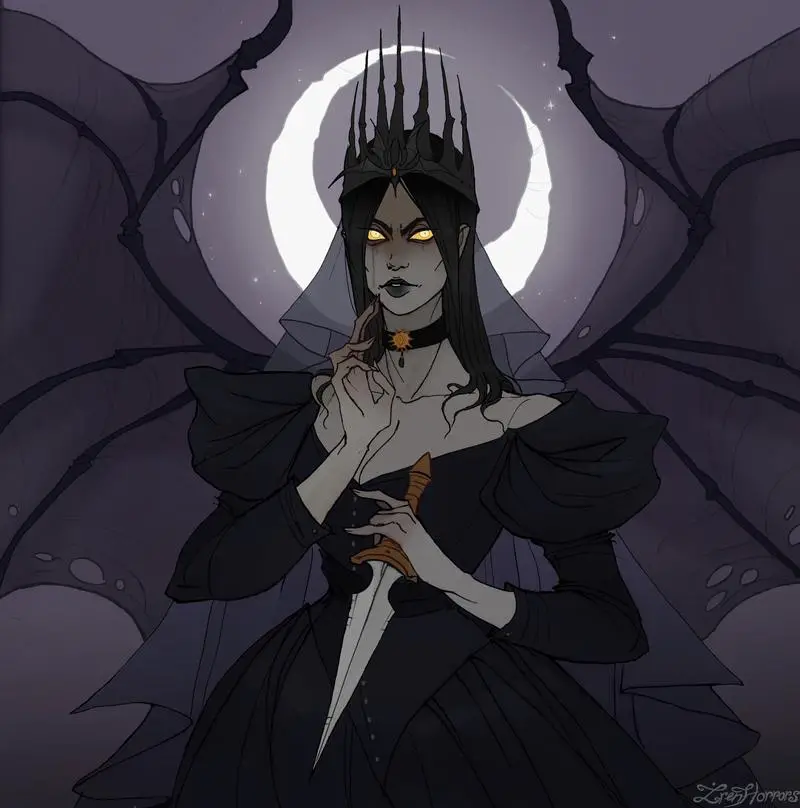
Powerful immortals who have “unlocked the secrets of everlasting life,” Undying patrons are sought after to share their secrets of life and death. There are many options for Undying patrons, including the following.
Art by IrenHorrors, CC License
Vecna: This lich-deity wandered the multiverse until his citadel became his prison. Author of the Book of Vile Darkness, Vecna frequently sponsors warlocks with his perspective as a former mortal who gained the secrets over life and death long ago. One desire of Vecna is to destroy the Raven Queen and her followers; another is to take revenge against the betraying vampire Kas, who battled him and destroyed his physical body.
Warlocks seduced to Vecna seek eternal life like their patron. They will fulfill Vecna’s vengeful deeds in exchange for this knowledge and power.
The Dread Luz: A demon lord of the Abyss, Luz is referred to as The Old Wicked and revered for his heinous skills in oppression, deceit, and pain. Luz believes that the weak deserved to be abused by the strong and that the best tools an enlightened one could use are deceit and guile. Luz believes that he, as the strongest and most deceitful, deserves to rule Oerth. All evil deeds enacted by his followers, no matter how cruel, dishonest, or devious, is met with approval by Luz.
Warlocks who enter a pact with Luz will likely be deceptive and cunning. They may have received power for some awful deed they committed that attracted the attention of this patron.
The Lich Queen Vol: Known also by her alias Lady Illmarrow, the cunning Vol originates from elven and draconic bloodlines. Brought back to life as a lich to lead a mostly-undead outlawed terrorist organization named after her dragon father, the Lich Queen desires to become the Queen of Death and take revenge against enemy dragons and elves. This patron keeps her identity secret in an effort to utilize covert intelligence and infiltrative reconnaissance through charming or influencing political players.
A Warlock who has chosen Vol as their patron may be a member of this order, or strive to become a member, and may wish to lead their own army of undead under the direction of Vol. They should be crafty in manipulation and cunning politically.
The Lich Queen Vlaakith: This githyanki Lich Queen was known for her jealousy and suspicion in her goals to become a deity. In an effort to keep her position, she would consume the souls of her followers who became too powerful. A woman learned in reading other people and learning their intentions, this Lich Queen is known for her powerful spellcasting and magic item crafting.
Warlocks who have pacts with Vlaakith may seek power but should keep themselves controlled enough to not force the ire of their patron. Warlocks interested in arcane, history, planar, and religious knowledge, perhaps as well as alchemical skills, would eagerly seek her vast expertise.
Fistandantalus: Radiating cold to the point where flora beneath his feet would whither, the Dark One Fistandantalus was a solo archmage who overcame his mortality by forsaking the neutral deity Gilean and accepting a Bloodstone from the Abyss deity Takhisis. Fistandantalus commonly accepted apprentices, though he would choose the strongest who had already passed the Test of High Sorcery and then lock their soul in his Bloodstone to give himself strength.
Warlocks who pact with Fistandantalus might be among several apprentices who unknowingly audition for this fate for the promise of power and knowledge.
Larloch the Shadow King: Former human sorcerer-king of ancient worlds, this lich became master of the Warlock’s Crypt and king of its undead and is one of the oldest and most powerful non-draconic mages in the realm. With godlike foresight and superintelligence, Larloch has a plan that always succeeds. Inventor of new spells, magic items, and magical techniques, Larloch is talented and sought after for his genius. However, Larloch’s extreme age has deeply afflicted his mind, causing him to be mad, erratic, and volatile. Though he often outright killed those who entered his presence, he enjoyed toying with clever and capable adventurers before their demise, sometimes bargaining with them to fulfill his cryptic deeds with a terrifying curse to provide as a reminder of whom they serve. The successful adventurers would be released from his banes unless they attempted to injure him.
Warlocks who pact with Larloch may suffer from some affliction bestowed by the Shadow King until they fulfill their promised quest.
Gilgeam: This cruel, prideful, jealous demigod, demoted for his abuse of his followers, is a handsome muscular immortal human-esque deity to the people of Unther. Unpopular among the mercantile community for the havoc his clergy caused for them, Gilgeam is relatively unpopular and often protested by his de facto followers.
Gilgeam may utilize a crusading Warlocks via their pact to help him retrieve all of the former land that he belongs to Unther. This Warlock will likely be politically controversial and likely irreverent, entitled, and oppressive.

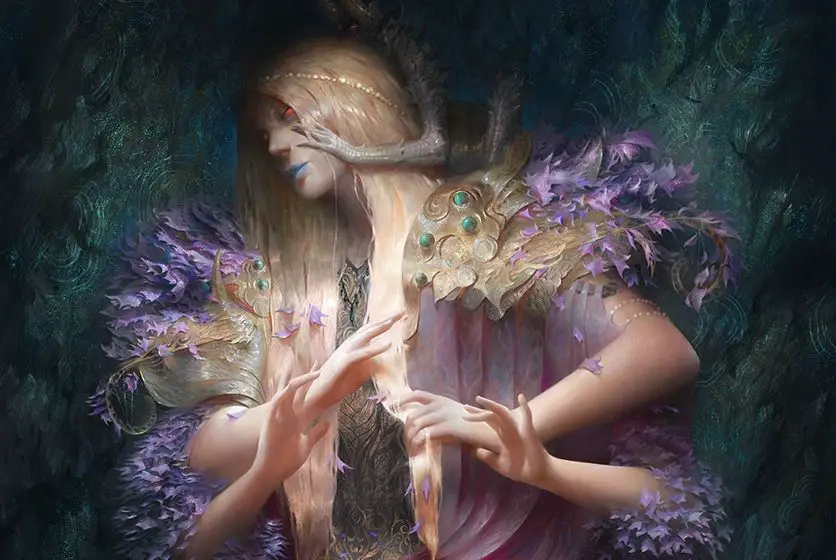


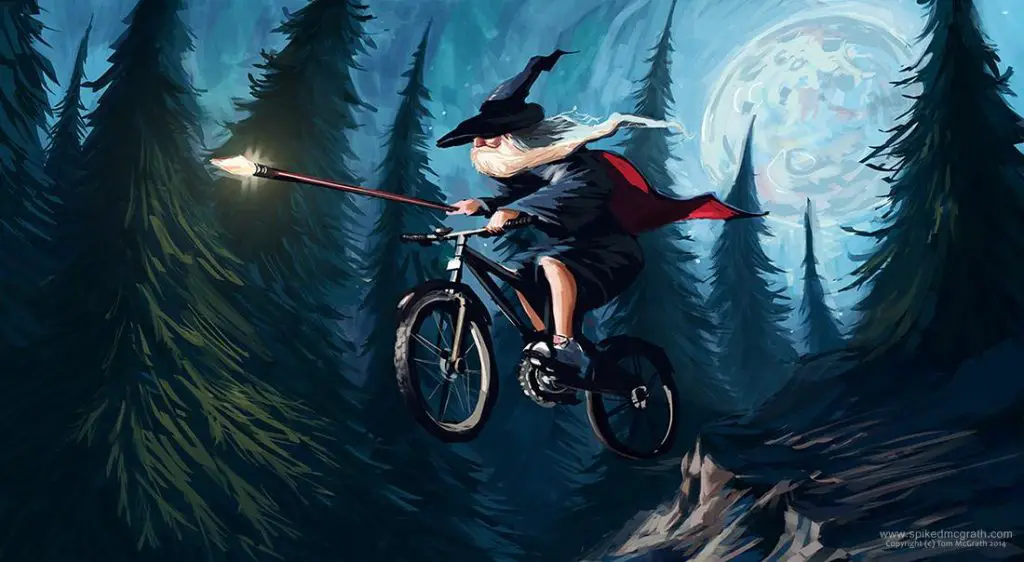
Great article! I really appreciate seeing the Eberron deities/Fae/entities represented.
They’re great! We’re glad you appreciate their inclusion.